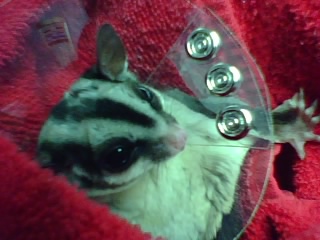I could write an entire novel JUST on the role nutrition plays in health and healing, but this will serve as a starting point for discussion:
DIET is a very controversial topic in the sugar glider community. Many argue that one diet is the most appropriate and others argue that another diet is most appropriate. However, one thing that all who love gliders agree upon is that a BALANCED diet with the appropriate ratios of calcium and phosphorus AS WELL AS the appropriate amount of vitamins, minerals and protein is NECESSARY for long health and well-being.
DIET matters to the sugar glider because they have a high metabolism and because they are susceptible to disease and illness resulting from long-term use of a diet that does not include all the elements required for health.
Among these, the most frequent is:
Hind Limb Paralysis or Metabolic Bone Disease - HLP results from a lack of calcium absorption. It sometimes results from long term use of a poor diet, but can also occur when a glider develops an infection that goes undetected. Infection (parasitic or bacterial) can inhibit calcium absorption.
Signs of HLP are slow movement, lack of using back or front legs, decreased appetite, change in activity level, clumsiness. If untreated, HLP is fatal. While being treated for infection, it is imperative that a glider be receiving a diet rich in nutrients and calcium from usable sources. Therefore, diet is important to the healing process.
Gliders can also develop Scurvy symptoms - While extremely rare, Scurvy results from a lack of vitamin C in the diet. Symptoms of scurvy are slow movement, tooth pain, not eating solid foods, bleeding gums, lethargy. If left untreated, scurvy is fatal.
Gliders can become malnourished even if fed every day. Malnourishment results from a lack of nutrients or an overabundance of certain nutrients in a diet. A glider can eat every day and still become malnourished. It is important that a diet for gliders be well thought out, highly nutritious and include a variety of usable vitamins and minerals.
Gliders are also prone to infection, abscess, biting, discoloration, lethargy and hair loss when fed a poor diet.
When or if a glider becomes ill or injured, the BEST defense a glider has is DIET. A glider who has been fed a nutritionally sound diet will heal faster and more completely than one that has not been fed properly. Once an injury occurs, a few slight modifications to an already good diet can decrease healing time and increase healing effectiveness.
Lastly, there is risk of poisoning (specifically aflatoxin poisoning) if a glider is fed a pelleted diet or a "cheap and easy" diet. One must research every thing they put into their little glider's belly and know benefits and risks. The risk of aflatoxin poisoning is greater with foods such as pellet diets, crickets, meal worms, etc.
For these reasons, it is essential that sugar gliders be fed a diet that has been developed with the aid of qualified professionals (including a vet), has been tested, and has proven to maintain healthy gliders.
The most well known tested and proven diets are: HPW, Priscilla Price’s diet, PML, BML, and the Suncoast diet. Other well-researched and frequently used diets can be found here in our diet section.
